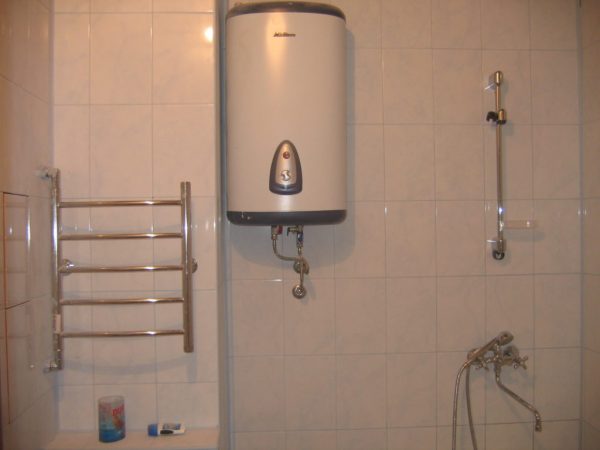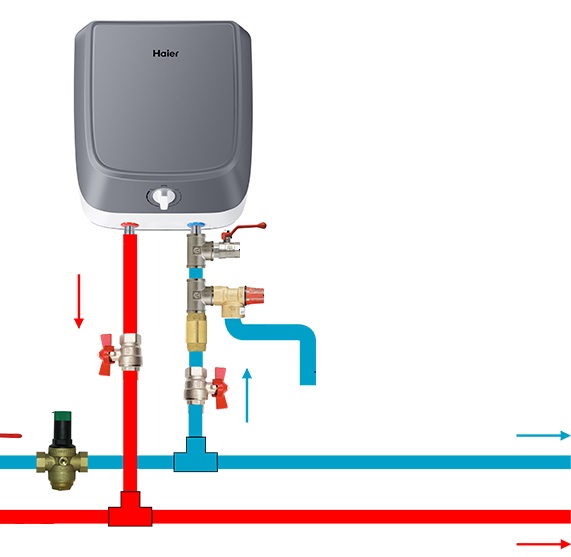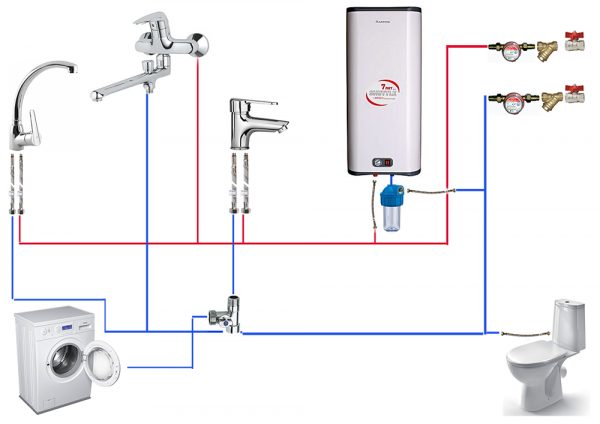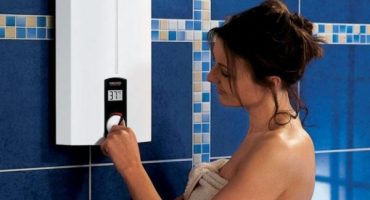In the summer season, a problem such as turning off hot water for a long time often appears. Therefore, many are trying to get home water heaters for such cases. It would seem that installing and connecting it is easier than ever. However, there are also some of its features.

Installation of a water heater in the bathroom
The first filling of the water heater
In order to understand how to properly fill the water heater with water and correctly operate it in the future, you should know the principle of operation. Consider the features of storage water heaters.
Internal arrangement of a water heater:
- Branch pipe of cold water intake.
- Electric heating element (TEN).
- Branch pipe of hot water intake.
The water in the tank is heated by natural convection. The cold water intake pipe and the heater are located in the lower part of the device, and the other pipe is set at its upper part. Cold water comes from the water pipe through the lower pipe. Since it is heavier than hot, it always remains from below heated and pushes the hot coolant up. Thus, uniform heating of the entire contents of the tank is achieved. As cold water enters, hot water enters the mixer through the upper nozzle.

The principle of the storage heater
It is important that you familiarize yourself with the technical manual prior to installation. It gives a detailed description of the device, how to use and install it correctly.
Many modern heaters are already equipped with non-return safety valves, this can be found in the instructions. But for reliability, you can install an additional external check valve. It is necessary so that in the absence of pressure in the water supply system, water does not go back into the pipes. Otherwise, the heater may heat the empty tank and burn out.
After installing all the valves, valves and connecting pipes, the water heater is ready for the first filling with water. The cold water hose is connected to the cold water pipe, and the hot water hose to the mixer. Make sure that the water heater is not connected to the mains. Next, we check the correct connection of the piping of hot and cold water, as well as the performance of all safety valves.

Schematic connection of the unit to the water supply network
After you have made sure that everything is working properly and correctly, you can proceed to filling the internal container with water. It is necessary to expel the air from the inside. To do this, open the tap of the mixer, make sure that there is no leak in the tap.
Then we open the cold water valve installed on the heater nozzle. The aqueous medium begins to evenly fill the tank and bleed air through an open mixer. The faucet will “sneeze” or “hiss”, this is a clear sign that air is coming out of the heating tank. Tap running water can sometimes contain air bubbles in itself. Therefore, it is necessary to drive out the water until the tap stops “sneezing” from the air outlet. The presence of air in the tank adversely affects the performance of the water heater.
IMPORTANT! Manufacturers themselves recommend not to leave airbags in the tank. Because of them, the water is heated unevenly, which reduces the efficiency of the device.
As soon as cold water flows from the tap without any extraneous sounds, it means that the water heater is full and ready for use.Now you can close the mixer and check the pipe connections for leaks. If they are not found, you can safely plug the device into the network and set the desired temperature of the water filling the tank. Do not immediately set the maximum temperature, as this can lead to damage to the thermostat.

Schematic device for connecting and operating a water heating system
Safety measures for the operation of a water heater
All electrical appliances require careful handling and safety precautions. Since the device is connected to an electric power supply network, it presents a special hazard class in which injuries from electric current are possible.
Therefore, always comply with the requirements to avoid personal injury and damage to the device:
- It is forbidden to remove the heater case with the plug plugged into the socket.
- The socket to which the heater will be connected must be grounded.
- Do not plug the tank into a power outlet if there is no water in it. You can check for its presence by opening the hot water tap. If she runs, then the tank is full.
- It is necessary to carry out timely maintenance of the tank: descaling and other impurities. This will protect him from damage.

Cleaning the water heater from scale and other impurities
It should be remembered that the most vulnerable elements of heaters are the heater and the storage tank. They are subject to the greatest loads of aggressive environments.



